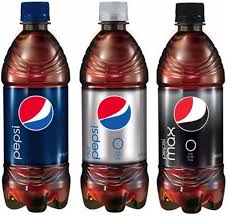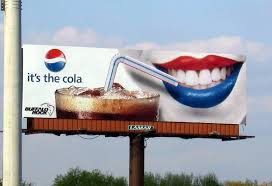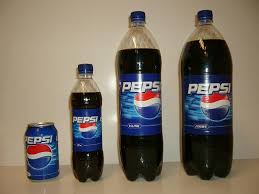Pepsi-Cola began as 'Brad's drink' was concocted by a pharmacist by the name of Caleb Bradham. He was a pharmacist working at a local drugstore in New Bern, North Carolina. He decided to create a drink that was not only tasty, but delicious.
Have you ever wondered who brought the idea of Pepsi-Cola to our world? Let's start at the beginning. It began in the late 1800's at a drugstore in New Bern, North Carolina. In those early days, a soda fountain was usually a part of the drugstore. This, of course, was the local hangout where townspeople could get together and talk about anything and everything.
In the drugstore in New Bern was a pharmacist named Caleb Bradham. Soda fountain drinks were always an interest to Bradham, so he concocted the idea to attempt to develop one. His development would include a drink that would help digestion and possibly give people a boost of energy.
An article in the Greensboro Daily News mentioned how Bradham was interested in developing a new soda fountain drink. Of course, in those days, drinks of this nature did not have a good reputation. They were thought to have harmful ingredients or so some of the doctors said. This put a thought in Bradham's mind to develop a drink that was different in that it would not only look appealing, but also taste good.
As expected Bradham succeeded in concocting a new soda fountain drink. During one of the local gatherings, he served the drink calling it "Brad's Drink". As more and more people tried this fountain drink, the news spread beyond the boundaries of New Bern. So in 1898, Brad's Drink was introduced to the market. He renamed the drink "˜Pepsi-Cola'. It is unclear as to how he derived the name.
It was believed that Pepsi-Cola was associated with pepsin. Of course, this does not mean the drink contained pepsin, but the drink was similar to that ingredient. Bradham felt the drink would aid in the digestive process, as does pepsin. The word cola did not mean the drink contained the kola nut, but only referred to the light and refreshing taste.

Now Bradham needed an area to manufacture this new drink. The original site used to manufacture the drink was the cellar below the drugstore. Once the ingredients were carried to the cellar there was little room to work, but that did not effect the production of Pepsi-Cola. A large kettle was a part of the décor used to cook the ingredients after they were carefully mixed. When the syrup was done, it was poured into one-gallon and five-gallon jugs. The reason for the jugs was for shipping to customers
Bradham realized in 1902 he had created something special. Therefore, he decided it was time to file incorporation papers in the state of North Carolina. Included in the incorporation papers he mentioned that he wanted to also introduce Pepsi-Cola in Virginia, Maryland, Pennsylvania, and New York. Bradham figured this popular drink would only be associated with the soda fountain business. As expected, Bradham was president, and his friends R.F. Butler and R.G. Credle joined with one share each. Believe it or not, $10,000 was the value of the shares during this period of time. Bradham never dreamed of what was to come.

Bradham began to wonder if he should obtain a patent on the Pepsi-Cola trademark. The reason was that he was concerned regarding the formula for the drink. So, on November 23, 1902 he applied for a patent. But, Bradham's luck ran out. There was a company with a product called Pep-Kola, which was too similar to the Pepsi-Cola. Therefore, the Pepsi-Cola trademark was rejected. What was Bradham to do? He had worked so hard to formulate this drink and was not about to give up. He bought the trademark Pep-Kola for $100. This was purchased from the Alphasol Company. Bradham's dream began, as Pepsi-Cola became the trademark. With this event in history, the starting date for Pepsi-Cola is unsure. But it was determined that 1898 was the starting date for this delicious drink.
In August of 1906, the first trademark for Pepsi-Cola was approved. Advertising the drink was an interesting story in itself. Word of mouth from people visiting New Bern played an important role in spreading the good news. They would return to their hometown to tell their friends and relatives about this terrific tasting drink. In the New Bern Weekly Journal, advertisements were found for Pepsi-Cola. But to Bradham's surprise the ad referred to the drink as having medicinal benefits. The ad associated the drink to aid in digestion, relieves headaches, and aid in getting rid of that tired feeling.
As news traveled, Bradham was unable to keep up the sales. The cellar below the drugstore seemed to get smaller and smaller. The first home office for the popular drink was formerly the Bishop factory, which Bradham purchased. At this point in time, Pepsi-Cola was sold in a glass for five cents! Bradham knew there had to be another way to develop a different container. William Painter should be given the credit for designing bottles with a perfect seal. So what was this called? This new idea was to be referred to as the "˜pop bottle cap'.
With his new bottling plant in place, the soft drink industry was beginning to blaze a new and different trail. Bradham's next idea was brilliant. He decided to offer tours of his bottling plant and give each guest a sample of his bottled drink. In 1907, the sales for Pepsi were increasing with each passing day. With this prosperity, Bradham wanted to introduce this new idea in Canada and Mexico. In Charlotte, North Carolina, the first franchise for Pepsi was located. It was incorporated on November 16, 1905. Now known as the Pepsi-Cola Company, there were 15 bottling plants franchised. In a newspaper ad in 1908, racecar driver Barney Oldfield did an advertisement for Pepsi-Cola.

Bradham concluded that he needed some assistance from a financial expert. He brought J.D. Farrior to the company as a vice president. Farrior was known as an investor and was given half of the shares of the stock of Pepsi. The bottling side of the business produced a 40 percent increase in business. Of course, with production increasing Bradham purchased the land adjacent to the present location and began construction. The parent company opened in Memphis, Tennessee in 1908. Bradham's dream was beginning to materialize. There were now 24 states licensed to bottle Pepsi-Cola and more than 250 bottlers in these designated states.
After years of success, the Pepsi-Cola Company faced bankruptcy in 1923. Bradham returned to that old familiar drugstore environment in New Bern. Not too long after bankruptcy, Pepsi-Cola was introduced at the Loft in New York City. Charles Guth became interested in the drink. A young chemist was hired by Guth after he acquired the formula for Pepsi-Cola. The young chemist, Richard J. Ritchie, was told that Guth was not satisfied with the taste. Therefore, Ritchie made some minor adjustments to the formula for Guth's approval. The Pepsi-Cola Company was now located in the New York Empire State Building. This location existed from 1932 until 1933. A bottler in Charlottesville noticed the problems encountered by Pepsi and decided to downsize by one employee five days before Christmas.

Guth felt the decision he had made earlier to promote Pepsi-Cola had been a mistake. Guth tried to sell Pepsi-Cola back to Roy Megargel because he owed him money for the transfer of the trademark. Even though Megargel did not repurchase Pepsi-Cola from Guth, he settled for a lesser amount on the money that Guth owed him.
Sadly, Bradham passed away on February 19, 1934 after suffering from a long illness. He was unable to live to see Pepsi-Cola become what it is today. In 1934, the franchise was only worth $315. Even though the company would change hands, the soft drink was still available. Surprising, in July 1934, Pepsi-Cola was being massed produced because of its popularity. It was now being sold in a 12-ounce bottle. Buying a franchise today could be worth millions, and as we know this product is sold throughout the world.
The bottling of Pepsi began in 1934 in Canada. Guth was the person responsible for bringing Pepsi-Cola all throughout the United States. Where would some of us be today without that refreshing and satisfying taste?
from - http://www.essortment.com/history-pepsi-cola-41716.html
In the drugstore in New Bern was a pharmacist named Caleb Bradham. Soda fountain drinks were always an interest to Bradham, so he concocted the idea to attempt to develop one. His development would include a drink that would help digestion and possibly give people a boost of energy.
An article in the Greensboro Daily News mentioned how Bradham was interested in developing a new soda fountain drink. Of course, in those days, drinks of this nature did not have a good reputation. They were thought to have harmful ingredients or so some of the doctors said. This put a thought in Bradham's mind to develop a drink that was different in that it would not only look appealing, but also taste good.
As expected Bradham succeeded in concocting a new soda fountain drink. During one of the local gatherings, he served the drink calling it "Brad's Drink". As more and more people tried this fountain drink, the news spread beyond the boundaries of New Bern. So in 1898, Brad's Drink was introduced to the market. He renamed the drink "˜Pepsi-Cola'. It is unclear as to how he derived the name.
It was believed that Pepsi-Cola was associated with pepsin. Of course, this does not mean the drink contained pepsin, but the drink was similar to that ingredient. Bradham felt the drink would aid in the digestive process, as does pepsin. The word cola did not mean the drink contained the kola nut, but only referred to the light and refreshing taste.
Now Bradham needed an area to manufacture this new drink. The original site used to manufacture the drink was the cellar below the drugstore. Once the ingredients were carried to the cellar there was little room to work, but that did not effect the production of Pepsi-Cola. A large kettle was a part of the décor used to cook the ingredients after they were carefully mixed. When the syrup was done, it was poured into one-gallon and five-gallon jugs. The reason for the jugs was for shipping to customers
Bradham realized in 1902 he had created something special. Therefore, he decided it was time to file incorporation papers in the state of North Carolina. Included in the incorporation papers he mentioned that he wanted to also introduce Pepsi-Cola in Virginia, Maryland, Pennsylvania, and New York. Bradham figured this popular drink would only be associated with the soda fountain business. As expected, Bradham was president, and his friends R.F. Butler and R.G. Credle joined with one share each. Believe it or not, $10,000 was the value of the shares during this period of time. Bradham never dreamed of what was to come.
Bradham began to wonder if he should obtain a patent on the Pepsi-Cola trademark. The reason was that he was concerned regarding the formula for the drink. So, on November 23, 1902 he applied for a patent. But, Bradham's luck ran out. There was a company with a product called Pep-Kola, which was too similar to the Pepsi-Cola. Therefore, the Pepsi-Cola trademark was rejected. What was Bradham to do? He had worked so hard to formulate this drink and was not about to give up. He bought the trademark Pep-Kola for $100. This was purchased from the Alphasol Company. Bradham's dream began, as Pepsi-Cola became the trademark. With this event in history, the starting date for Pepsi-Cola is unsure. But it was determined that 1898 was the starting date for this delicious drink.
In August of 1906, the first trademark for Pepsi-Cola was approved. Advertising the drink was an interesting story in itself. Word of mouth from people visiting New Bern played an important role in spreading the good news. They would return to their hometown to tell their friends and relatives about this terrific tasting drink. In the New Bern Weekly Journal, advertisements were found for Pepsi-Cola. But to Bradham's surprise the ad referred to the drink as having medicinal benefits. The ad associated the drink to aid in digestion, relieves headaches, and aid in getting rid of that tired feeling.
As news traveled, Bradham was unable to keep up the sales. The cellar below the drugstore seemed to get smaller and smaller. The first home office for the popular drink was formerly the Bishop factory, which Bradham purchased. At this point in time, Pepsi-Cola was sold in a glass for five cents! Bradham knew there had to be another way to develop a different container. William Painter should be given the credit for designing bottles with a perfect seal. So what was this called? This new idea was to be referred to as the "˜pop bottle cap'.
With his new bottling plant in place, the soft drink industry was beginning to blaze a new and different trail. Bradham's next idea was brilliant. He decided to offer tours of his bottling plant and give each guest a sample of his bottled drink. In 1907, the sales for Pepsi were increasing with each passing day. With this prosperity, Bradham wanted to introduce this new idea in Canada and Mexico. In Charlotte, North Carolina, the first franchise for Pepsi was located. It was incorporated on November 16, 1905. Now known as the Pepsi-Cola Company, there were 15 bottling plants franchised. In a newspaper ad in 1908, racecar driver Barney Oldfield did an advertisement for Pepsi-Cola.
Bradham concluded that he needed some assistance from a financial expert. He brought J.D. Farrior to the company as a vice president. Farrior was known as an investor and was given half of the shares of the stock of Pepsi. The bottling side of the business produced a 40 percent increase in business. Of course, with production increasing Bradham purchased the land adjacent to the present location and began construction. The parent company opened in Memphis, Tennessee in 1908. Bradham's dream was beginning to materialize. There were now 24 states licensed to bottle Pepsi-Cola and more than 250 bottlers in these designated states.
After years of success, the Pepsi-Cola Company faced bankruptcy in 1923. Bradham returned to that old familiar drugstore environment in New Bern. Not too long after bankruptcy, Pepsi-Cola was introduced at the Loft in New York City. Charles Guth became interested in the drink. A young chemist was hired by Guth after he acquired the formula for Pepsi-Cola. The young chemist, Richard J. Ritchie, was told that Guth was not satisfied with the taste. Therefore, Ritchie made some minor adjustments to the formula for Guth's approval. The Pepsi-Cola Company was now located in the New York Empire State Building. This location existed from 1932 until 1933. A bottler in Charlottesville noticed the problems encountered by Pepsi and decided to downsize by one employee five days before Christmas.
Guth felt the decision he had made earlier to promote Pepsi-Cola had been a mistake. Guth tried to sell Pepsi-Cola back to Roy Megargel because he owed him money for the transfer of the trademark. Even though Megargel did not repurchase Pepsi-Cola from Guth, he settled for a lesser amount on the money that Guth owed him.
Sadly, Bradham passed away on February 19, 1934 after suffering from a long illness. He was unable to live to see Pepsi-Cola become what it is today. In 1934, the franchise was only worth $315. Even though the company would change hands, the soft drink was still available. Surprising, in July 1934, Pepsi-Cola was being massed produced because of its popularity. It was now being sold in a 12-ounce bottle. Buying a franchise today could be worth millions, and as we know this product is sold throughout the world.
The bottling of Pepsi began in 1934 in Canada. Guth was the person responsible for bringing Pepsi-Cola all throughout the United States. Where would some of us be today without that refreshing and satisfying taste?
from - http://www.essortment.com/history-pepsi-cola-41716.html

No comments:
Post a Comment